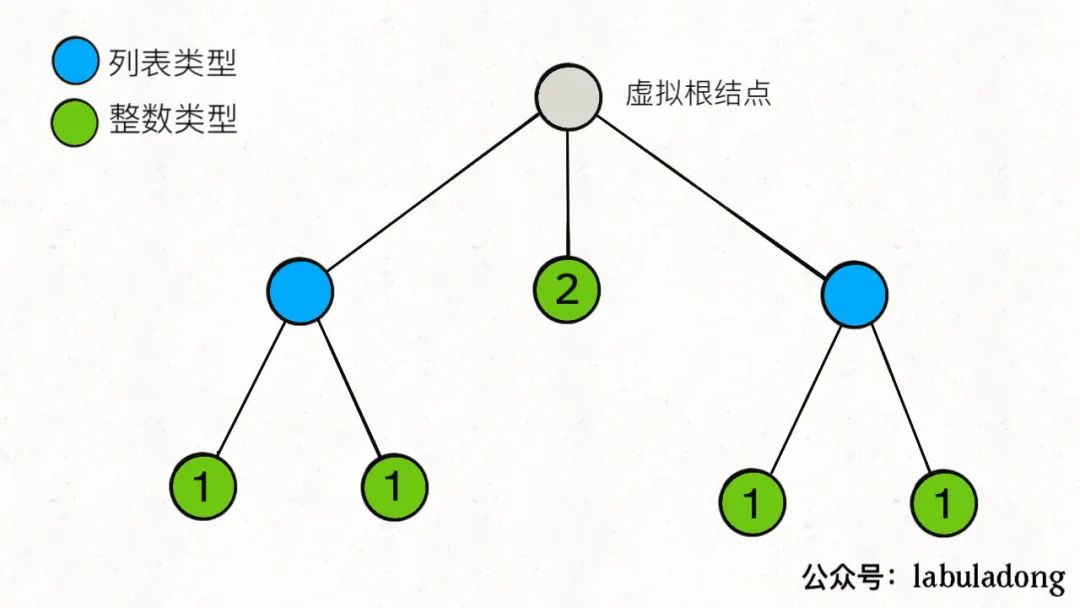题目描述
解法:递归
这道题最重要的是先理解题意,在理解的情况下,其实我们要做的就是一棵 N 叉树的遍历,为什么这样说呢?
比如说输入是
[
[
1
,
1
]
,
2
,
[
1
,
1
]
]
[[1,1],2,[1,1]]
[[1,1],2,[1,1]],其实就是如下树状结构:

把一个 NestedInteger 扁平化就等价于遍历一棵 N 叉树的所有「叶子节点」,我把所有叶子节点都拿出来,不就可以作为迭代器进行遍历了吗?
有了如此思路,下面的代码就容易解决了
/**
* // This is the interface that allows for creating nested lists.
* // You should not implement it, or speculate about its implementation
* class NestedInteger {
* public:
* // Return true if this NestedInteger holds a single integer, rather than a nested list.
* bool isInteger() const;
*
* // Return the single integer that this NestedInteger holds, if it holds a single integer
* // The result is undefined if this NestedInteger holds a nested list
* int getInteger() const;
*
* // Return the nested list that this NestedInteger holds, if it holds a nested list
* // The result is undefined if this NestedInteger holds a single integer
* const vector<NestedInteger> &getList() const;
* };
*/
class NestedIterator {
private:
vector<int>::iterator cur;
vector<int> res;
void traverse(NestedInteger root){
if (root.isInteger())
{
res.push_back(root.getInteger());
return;
}
for (NestedInteger child: root.getList())
traverse(child);
}
public:
NestedIterator(vector<NestedInteger> &nestedList) {
for (NestedInteger node: nestedList)
traverse(node);
cur = res.begin();
}
int next() {
return *cur++;
}
bool hasNext() {
return cur != res.end();
}
};
/**
* Your NestedIterator object will be instantiated and called as such:
* NestedIterator i(nestedList);
* while (i.hasNext()) cout << i.next();
*/
以上解法虽然可以通过,但是在面试中,也许是有瑕疵的
我们的解法中,一次性算出了所有叶子节点的值,全部装到 res 列表,也就是内存中,next 和 hasNext 方法只是在对 res 列表做迭代。如果输入的规模非常大,构造函数中的计算就会很慢,而且很占用内存
一般的迭代器求值应该是「惰性的」,也就是说,如果你要一个结果,我就算一个(或是一小部分)结果出来,而不是一次把所有结果都算出来
如果想做到这一点,使用递归函数进行 DFS 遍历肯定是不行的,而且我们其实只关心「叶子节点」,所以传统的 BFS 算法也不行。实际的思路很简单:
调用 hasNext 时,如果 nestedList 的第一个元素是列表类型,则不断展开这个元素,直到第一个元素是整数类型
由于调用 next 方法之前一定会调用 hasNext 方法,这就可以保证每次调用 next 方法的时候第一个元素是整数型,直接返回并删除第一个元素即可
/**
* // This is the interface that allows for creating nested lists.
* // You should not implement it, or speculate about its implementation
* class NestedInteger {
* public:
* // Return true if this NestedInteger holds a single integer, rather than a nested list.
* bool isInteger() const;
*
* // Return the single integer that this NestedInteger holds, if it holds a single integer
* // The result is undefined if this NestedInteger holds a nested list
* int getInteger() const;
*
* // Return the nested list that this NestedInteger holds, if it holds a nested list
* // The result is undefined if this NestedInteger holds a single integer
* const vector<NestedInteger> &getList() const;
* };
*/
class NestedIterator {
private:
list<NestedInteger> mylist;
public:
NestedIterator(vector<NestedInteger> &nestedList) {
mylist = list<NestedInteger>(nestedList.begin(), nestedList.end());
}
int next() {
auto tmp = mylist.front().getInteger();
mylist.pop_front();
return tmp;
}
bool hasNext() {
while (!mylist.empty() && !mylist.front().isInteger())
{
auto first = mylist.front().getList();
mylist.pop_front();
for (int i = first.size() - 1; i >= 0; i--)
mylist.insert(mylist.begin(), first[i]);
}
return !mylist.empty();
}
};
/**
* Your NestedIterator object will be instantiated and called as such:
* NestedIterator i(nestedList);
* while (i.hasNext()) cout << i.next();
*/
解法:栈
我们可以用一个栈来代替方法一中的递归过程
具体来说,用一个栈来维护深度优先搜索时,从根节点到当前节点路径上的所有节点。由于非叶节点对应的是一个列表,我们在栈中存储的是指向列表当前遍历的元素的指针(下标)。每次向下搜索时,取出列表的当前指针指向的元素并将其入栈,同时将该指针向后移动一位。如此反复直到找到一个整数。循环时若栈顶指针指向了列表末尾,则将其从栈顶弹出
下面的代码中, C++ \texttt{C++} C++ 的栈存储的是迭代器,迭代器可以起到指向元素的指针的效果
/**
* // This is the interface that allows for creating nested lists.
* // You should not implement it, or speculate about its implementation
* class NestedInteger {
* public:
* // Return true if this NestedInteger holds a single integer, rather than a nested list.
* bool isInteger() const;
*
* // Return the single integer that this NestedInteger holds, if it holds a single integer
* // The result is undefined if this NestedInteger holds a nested list
* int getInteger() const;
*
* // Return the nested list that this NestedInteger holds, if it holds a nested list
* // The result is undefined if this NestedInteger holds a single integer
* const vector<NestedInteger> &getList() const;
* };
*/
class NestedIterator {
private:
// pair 中存储的是列表的当前遍历位置,以及一个尾后迭代器用于判断是否遍历到了列表末尾
stack<pair<vector<NestedInteger>::iterator, vector<NestedInteger>::iterator>> stk;
public:
NestedIterator(vector<NestedInteger> &nestedList) {
stk.emplace(nestedList.begin(), nestedList.end());
}
int next() {
// 由于保证调用 next 之前会调用 hasNext,直接返回栈顶列表的当前元素,然后迭代器指向下一个元素
auto tmp = stk.top().first->getInteger();
stk.top().first++;
return tmp;
}
bool hasNext() {
while (!stk.empty())
{
auto& p = stk.top();
if (p.first == p.second)
{
// 遍历到当前列表末尾,出栈
stk.pop();
continue;
}
if (p.first->isInteger())
return true;
auto& lst = p.first->getList();
p.first++;
stk.emplace(lst.begin(), lst.end());
}
return false;
}
};
/**
* Your NestedIterator object will be instantiated and called as such:
* NestedIterator i(nestedList);
* while (i.hasNext()) cout << i.next();
*/






















 490
490











 被折叠的 条评论
为什么被折叠?
被折叠的 条评论
为什么被折叠?








